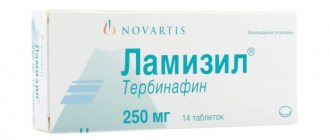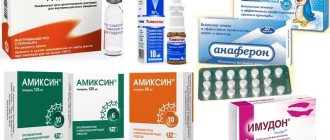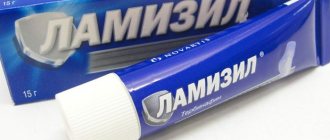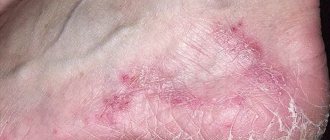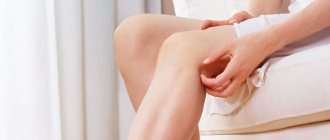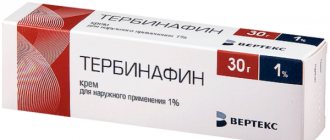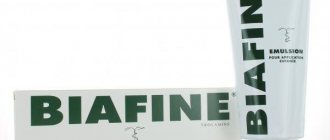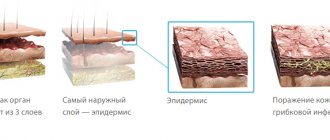Only a dermatologist can reliably diagnose a fungal infection. Often this disease is disguised as neurodermatitis or psoriasis. Self-medication can be dangerous to the patient’s health, so it is imperative to undergo an examination by a doctor, and only then begin therapy.
A wide range of local medications are used to target fungal microflora. Lamisil cream is considered one of the most effective, with which you can not only get rid of unpleasant symptoms, but also cure the skin. The drug in question inhibits the activity of pathogens and neutralizes their spread to healthy segments of the dermis.
Compound
Lamisil tablets contain the active component terbinafine (in the form of hydrochloride), as well as additional components: colloidal anhydrous silicon dioxide, magnesium stearate, sodium starch glycolate, MCC, methylhydroxypropylcellulose.
Lamisil spray contains terbinafine hydrochloride as an active component, as well as additional components: 96% ethanol, macrogol cetostearate, propylene glycol, water.
The ointment contains the active component terbinafine hydrochloride , as well as additional substances: sodium hydroxide, benzyl alcohol, sorbitan stearate, stearyl alcohol, cetyl palmitate, cetyl alcohol, isopropyl myristate, polysorbate 60, water.
Release form
Several forms of this medicine are produced.
Lamisil tablets can be white or white-yellow in color, they are biconvex, round, scored, and chamfered. Around the tablet is the inscription “LAMISIL 250“. The surface of the tablet is rough. Contained in blisters of 7 or 14 pieces, the blisters are placed in cardboard packs.
Lamisil spray is a colorless transparent liquid (may have a light yellow tint) with a characteristic odor. Contained in polyethylene bottles equipped with a spray tip, 15 and 30 ml. The bottle is placed in cardboard packs.
Lamisil ointment is homogeneous, white in color, and has a slight characteristic odor. Contained in aluminum tubes of 15 and 30 g each. The tubes are placed in cardboard packs.
pharmachologic effect
Lamisil is an antifungal agent.
Terbinafine is an allylamine that has a wide spectrum of action against fungi. Acts on fungi that cause diseases of the hair, nails, and skin. These are Trichophyton fungi (for example, Trichophyton tonsurans, Trichophyton mentagrophytes, Trichophyton rubrum, Trichophyton violaceum, Trichophyton verrucosum), Epidermophyton floccosum, Microsporum (Microsporum canis), Candida yeast fungi (Candida albicans) and Pityrosporum.
When used in low concentrations, terbinafine produces a fungicidal effect against dermatophytes, molds and a number of dimorphic fungi. Concerning yeast fungi, it demonstrates fungicidal or fungistatic activity.
Under the influence of terbinafine, the biosynthesis of sterols in the cell is specifically suppressed at a very early stage. As a result, there is a lack of ergosterol and accumulation of squalene inside the cells, as a result of which the fungal cells die. Terbinafine works by inhibiting the enzyme squalene epoxidase in the fungal cell membrane.
If Lamisil is prescribed orally, the concentrations of the drug that provide a fungicidal effect accumulate in the skin, nails and hair.
When used externally, the drug also demonstrates a wide spectrum of antifungal activity.
Terbinafine does not affect the cytochrome P450 system, so it does not affect the metabolism of hormones and other drugs.
Description of the drug
Lamisil cream (ointment) is a broad-spectrum antifungal pharmaceutical agent. It is used only externally, locally. The drug contains only one active component - terbinafine. This substance exhibits high activity against mold, dimorphic, yeast fungi, as well as dermatophytes.
The antifungal effect of terbinafine varies from fungistatic to fungicidal, depending on the type of pathogen and the concentration of the drug during treatment.
What does Lamisil ointment help with? With the help of liniment you get rid of:
- skin lesions of fungal etiology;
- mycoses;
- candidiasis;
- depriving;
- Diaper rash.
Before applying the cream, it is important to consult a specialist, since only an experienced doctor can establish an accurate diagnosis for the patient and prescribe effective therapy. To eliminate the pathogenic process, a specific dosage form is prescribed in each specific case: tablets, spray or cream.
Clinical and pharmacological group
Cream (ointment) Lamisil is a representative of one of the most extensive clinical and pharmacological groups - antifungal agents. This is a broad-spectrum drug. His main “specialization” is the treatment of infectious pathologies of the skin, nails, mucous membranes and hair. The drug in question is characterized by selective activity.
pharmachologic effect
The main active ingredient of Lamisil gel is terbinafine. The mechanism of its pharmacological action is to inhibit the activity of pathogenic microflora.
The indicated activity is realized at the cellular level:
- terbinafine specifically affects the biochemical metabolic reactions occurring in fungal sterols;
- a high concentration of squalene accumulates inside pathogenic cells, causing necrosis of pathogenic microorganisms;
- in parallel, a deficiency of a substance called ergosterol is formed, which ensures the molecular permeability of fungi;
- the active component of the ointment inhibits squalene epoxidase (a special enzyme locally located on the membranes of pathogenic cells).
The peculiarity of terbinafine is that it does not affect other hormones in the human body and can be used simultaneously with other dosage forms. Liniment not only stops the spread of pathogenic microflora, but also destroys it at the cellular level.
Release form and composition
External forms of the drug Lamisil (spray (gel), cream and ointment) are supplied in metal tubes of 30, 25 and 5 g. Depending on the location and degree of damage by fungal pathogens, one of the listed forms is prescribed. The selection is made by a dermatologist based on the ease of use of the medication, the area of localization of the disease, and the general condition of the skin.
Many patients are interested in what is better, gel or cream? The effectiveness of these forms is similar, since the concentration of the active substance in them does not exceed 1%. Therefore, this formulation of the question is, in principle, not logical.
Composition of Lamisil ointment (in addition to terbinafine hydrochloride):
- ethanol;
- isopropyl myristate;
- benzyl alcohol;
- sodium hydroxide;
- purified water;
- artificial thickener based on carbomer (947P);
- polysorbate 20.
The cream form of the medication is best suited for treating skin affected by the disease. It is evenly distributed throughout the epithelial layer and has a high absorption rate.
Storage conditions and periods
According to the official recommendations indicated in the annotation, Lamisil cream is stored in a place protected from moisture and light. To preserve the medicinal properties of the drug, it is important that the temperature does not exceed +25 °C. Otherwise, the therapeutic effectiveness of the drug will be nominal, and the drug itself will be potentially dangerous.
The medication can be stored in a sealed aluminum tube for up to 24 months. After the specified period, you must get rid of the cream.
Pharmacokinetics and pharmacodynamics
After Lamisil tablets have been taken orally, terbinafine is well absorbed; the level of absolute bioavailability of terbinafine due to the “first pass” effect is about 50%. After the drug has been taken at a dose of 250 mg orally, the maximum plasma concentration is observed after 1.5 hours.
The maximum concentration increases if the drug is taken regularly.
Food intake has little effect on the bioavailability of the active substance; therefore, there is no need to adjust the dose of the drug when taken simultaneously with food.
Terbinafine is 99% bound to plasma proteins. Its rapid penetration through the dermal layer of the skin and concentration in the lipophilic stratum corneum are noted. Its high concentrations are also noted in hair, hair follicles, and skin with a large number of sebaceous glands. The presence of the active component of the drug in the nail plates is determined in the first weeks after the start of treatment.
metabolites are formed that do not demonstrate antifungal activity and are excreted mainly through the kidneys.
If Lamisil cream or spray is applied topically, the absorption of terbinafine is less than 5%. There is minor systemic exposure.
Action
The active component of Lamisil is the antifungal substance terbinafine. It has a selective effect on pathogens that cause mycoses, candidiasis, onychomycosis, and lichen. Can be used on any area of the epidermis, head, nails, hair.
The active component disrupts the protein bond in the cells of pathogenic microorganisms, causing the death of fungi. A layer of cream stays on the skin for about 3 days. The substances are absorbed gradually and have a local effect. An hour after application, 20% of terbinafine penetrates into the epidermis. About 5% enters the blood. The action begins almost immediately, the therapeutic effect is observed within several days.
They are produced in several forms for external use - gel, cream or ointment, spray, lotion, and for oral administration - tablets. The products are manufactured by the pharmaceutical company NOVARTIS. When choosing the form of a drug, you need to take into account the severity of the disease, the duration of the disease, the degree of damage, and the availability of use.
To treat the skin outside the head, cream is most often used. The product is easy to apply and has fast penetrating ability. The concentration of active components is similar to all other forms for external use - 1%. Packaged in tubes of 15 g, 30 g. You can hear the phrase “Lamisil ointment”. This means cream.
Indications for use
It is advisable to take Lamisil tablets in the following cases:
- with onychomycosis , which occurs due to exposure to dermatophyte fungi;
- for mycoses of the scalp;
- for fungal infections of the skin - treatment of foot fungus, dermatomycosis of the legs, torso, as well as for the treatment of infections caused by fungi of the genus Candida.
Please note that oral Lamisil is not an effective treatment for lichen versicolor .
It is advisable to use Lamisil cream and spray in the following cases:
- for the purpose of preventing mycoses of the feet, fungal infections of smooth skin, inguinal athlete's foot, which were provoked by dermatophytes;
- for the treatment of diaper rash caused by mold fungi;
- for the treatment of versicolor, caused by dimorphic fungi.
Contraindications
The drug is not prescribed to people who suffer from hypersensitivity to the components of the drug. You should not treat nail fungus and other diseases with Lamisil if the patient suffers from liver disease, both chronic and acute. Therefore, before starting treatment, it is necessary to determine whether the patient suffers from such diseases.
It should also be taken into account that hepatoxicity may occur both in people with liver disease and in those who have not suffered from such diseases. Therefore, patients should know that if, while using the product, constant nausea, a feeling of fatigue, jaundice, pain in the right hypochondrium, darkening of the urine, etc. appear, they should definitely consult a specialist and conduct a liver examination.
It is not recommended to take Lamisil for people with impaired renal function.
Side effects
Patients generally tolerate Lamisil well; side effects are usually mild to moderate and transient. Negative manifestations may be the following:
- Hematopoiesis : in very rare cases - agranulocytosis, neutropenia, pancytopenia, thrombocytopenia.
- Immune system : in very rare cases - lupus erythematosus , anaphylactoid reactions.
- Nervous system : headache , taste disturbances up to loss, in rare cases - paresthesia , dizziness , hypoesthesia .
- Hepatobiliary system : in rare cases - hepatobiliary dysfunction, liver failure.
- Digestion : loss of appetite , feeling of fullness in the stomach, nausea, dyspepsia, diarrhea , abdominal pain.
- Skin reactions : mild skin manifestations in the form of urticaria and rash, in rare cases - severe skin reactions, exacerbation of psoriasis , hair loss.
- Musculoskeletal system : myalgia, arthralgia.
- When using the spray, allergic skin manifestations may develop.
Instructions for use of Lamisil (Method and dosage)
The duration of use of all forms of the drug depends on the severity of the disease and the doctor’s prescription.
Instructions for Lamisil tablets
As a rule, adult patients are prescribed 250 mg of the drug once a day. For children, tablets are prescribed in a dose that depends on their weight. For a child weighing up to 20 kg, 62.5 mg per day is prescribed. If the patient's body weight is from 20 to 40 kg, 125 mg is prescribed; if the child's weight is more than 40 kg, he is prescribed 250 mg.
For dermatomycosis of the feet, treatment, depending on the patient’s condition, lasts from 2 to 6 weeks. For patients with dermatomycosis of the legs, torso , as well as skin candidiasis, treatment lasts from 2 to 4 weeks. For mycosis of the scalp, it is recommended to treat for 4 weeks. Patients with onychomycosis should take the drug for 6 to 12 weeks.
Spray Lamisil, instructions for use
The spray can be used by adult patients 1 or 2 times a day, depending on the doctor’s prescription. Before applying the product, you need to clean and dry those areas of the skin that have been affected by the disease. You need to spray Lamisil in such an amount as to completely moisturize the affected areas, and also apply it to the adjacent parts of the skin. As a rule, for dermatomycosis, diaper rash, and inguinal athlete's foot, treatment continues for one week, and the spray is sprayed once a day. Patients with lichen versicolor are prescribed to use the spray 2 times a day for 1 week. This remedy is not prescribed to children, as there is not enough experience in using the medicine in children.
Lamisil cream, instructions for use
The ointment can be used 1-2 times a day to treat adult patients and children over 12 years of age. Before applying the product, you need to thoroughly clean the skin and dry it. The cream should be applied to the affected areas of the skin, as well as to the places next to them. Apply a thin layer and rub lightly into the skin. If it is necessary to cure diaper rash, you can cover the areas where the cream is applied with gauze. It is advisable to do this at night. For dermatomycosis of the feet, treatment lasts for 1 week, you need to apply the cream once a day. If the product is prescribed for cracks and itching of the skin that develop as a result of a fungus, treatment lasts two weeks, the product should be applied 1-2 times a day. Patients with skin candidiasis need to use the cream 1-2 times a day; treatment, depending on the patient’s condition, lasts 1-2 weeks. Patients with lichen versicolor should be treated for two weeks, applying ointment 1-2 times a day.
If the remedy for foot fungus and other diseases is not used regularly, the risk of recurrence of the infection increases.
Lamisil Cream for the treatment of foot fungus, cream 1% 30g
A country
Switzerland
The country of production may vary depending on the batch of goods. Please check with the operator for detailed information when confirming your order.
Active substance
Terbinafine
Description
Lamisil cream is used to prevent and treat fungal skin infections, including athlete's foot.
The active substance of the cream Lamisil terbinafine has a fungicidal effect, with which it fights infection that causes fungus (mycosis) of the foot.* Suitable for use in adults and children over 12 years of age.* * Instructions for medical use, RU No. P N008851 dated 06/10/2010
Compound
Composition (per 1 g): Active ingredient mg: Terbinafine hydrochloride 10.0 Excipients: Sodium hydroxide* 1.2 Benzyl alcohol 10.0 Sorbitan stearate 19.0 Cetyl palmitate 20.0 Stearyl alcohol 40.0 Cetyl alcohol 40.0 Polysorbate-60 61.0 Isopropyl myristate 80.0 Purified water 718.8 *-Sodium hydroxide 30% solution by weight.
Product description
White homogeneous or almost homogeneous smooth cream with a weak characteristic odor.
pharmachologic effect
An antifungal drug for external use with a wide spectrum of antifungal activity. In small concentrations, terbinafine has a fungicidal effect against dermatophytes (Trychophyton rubrum, T.mentagrophytes, T.verrucosum, T.violaceum, T.tonsurans, Microsporum canis, Epidermophyton floccosum), yeast (mainly C.albicans) and certain dimorphic fungi ( Pityrosporum orbiculare or Mallassezia Furfur). Activity against yeast fungi, depending on their type, can be fungicidal or fungistatic. Terbinafine specifically alters the early stage of sterol biosynthesis occurring in fungi. This leads to ergosterol deficiency and intracellular accumulation of squalene, which causes the death of the fungal cell. Terbinafine acts by inhibiting the enzyme squalene epoxidase located on the cell membrane of the fungus. Terbinafine does not affect the cytochrome P450 system in humans and, accordingly, the metabolism of hormones or other drugs. When used externally, absorption is less than 5% and has a slight systemic effect.
Indications for use
Treatment of fungal skin infections, including mycoses of the feet (“fungus” of the foot), tinea cruris, fungal infections of the smooth skin of the body (tinea corporis) caused by dermatophytes such as Trichophyton (including T. rubrum, T mentagrophytes, T. verrucosum, T. violaceum), Microsporum canis and Epidermophyton floccosum. Yeast infections of the skin, mainly those caused by the Candida genus (eg, Candida albicans), particularly diaper rash. Versicolor (Pityriasis versicolor), caused by Pityrosporum orbiculare (also known as Malassezia furfur).
Contraindications
If you are hypersensitive to terbinafine or to any component of the drug; - During breastfeeding; - Children under 12 years of age due to insufficient data on effectiveness and safety.
Carefully
If you have one of the following diseases/conditions/risk factors, be sure to consult your doctor before taking the drug: - liver and/or kidney failure; - alcoholism; - inhibition of bone marrow hematopoiesis; - tumors; - metabolic diseases; - occlusive vascular diseases of the extremities; - pregnancy.
Use during pregnancy and lactation
Pregnancy In experimental studies, teratogenic properties of terbinafine were not identified. To date, no malformations have been reported with the use of Lamisil cream. Animal studies have not revealed any adverse effects on pregnancy or fetal health. However, since clinical experience with Lamisil cream in pregnant women is very limited, it should not be used unless absolutely necessary. During pregnancy, it is used only if the expected benefit to the mother outweighs the potential risk to the fetus. You should consult your doctor. Breastfeeding period Terbinafine is excreted in breast milk, so the drug should not be used by nursing mothers. The infant should not be allowed to come into contact with any surface of the skin treated with Lamisil cream.
Directions for use and doses
Externally. Adults and children over 12 years of age: Before applying the cream, clean and dry the affected areas. The cream is applied once or twice a day in a thin layer to the affected skin and surrounding areas and rubbed in lightly. For infections accompanied by diaper rash (under the mammary glands, in the spaces between the fingers, between the buttocks, in the groin area), the places where the cream is applied can be covered with gauze, especially at night. For extensive fungal lesions of the body, it is recommended to use the cream in tubes of 30 g. Average duration of treatment: - Dermatomycosis of the trunk, legs: 1 week, 1 time per day. — Dermatomycosis of the feet: 1 week, 1 time per day. — Skin candidiasis: 1-2 weeks, 1 or 2 times a day. — Lichen versicolor: 2 weeks, 1 or 2 times a day. A decrease in the severity of clinical manifestations is usually noted in the first days of treatment. If treatment is not regular or is stopped prematurely, there is a risk of the infection returning. If after one to two weeks of treatment there are no signs of improvement, the diagnosis should be verified. The dosage regimen for Lamisil cream in the elderly does not differ from that described above. Use of the drug in children. The use of this drug in children under 12 years of age is not recommended.
Side effect
Adverse reactions are listed below according to organ system classes and frequency of occurrence. The frequency of adverse reactions is determined as follows: very often (≥ 1/10); common (≥ 1/100 and Immune system disorders: Not known: hypersensitivity reactions (rash). Eye disorders: Rare: eye irritation. Skin and subcutaneous tissue disorders: Common: skin flaking, itching. Uncommon: skin damage, crusting, skin lesions, pigmentation disorder, erythema, burning sensation of the skin Rare: dry skin sensation, contact dermatitis, eczema Frequency unknown: rash General and injection site disorders: Uncommon: pain, pain at the application site , irritation at the site of application. Rarely: exacerbation of symptoms of the disease. At the site of application of the drug, itching, peeling of the skin, pain, irritation, changes in skin pigmentation, burning, erythema, crusts may be observed. These minor symptoms should be distinguished from hypersensitivity reactions such as rash occur in rare cases and require discontinuation of therapy. In rare cases, the course of a fungal infection may worsen. If any of the side effects indicated in the instructions get worse, or you notice any other side effects not listed in the instructions, tell your doctor
Overdose
No cases of drug overdose have been reported. Low systemic absorption of terbinafine for external use virtually eliminates overdose when applying the drug to the skin. Accidental ingestion of the contents of one 30 g tube of cream containing 300 mg terbinafine hydrochloride (equivalent to 264 mg terbinafine base) is comparable to taking one 250 mg terbinafine tablet (single oral dose for adults). Symptoms Signs of overdose after ingestion of terbinafine may include headache, nausea, epigastric pain and dizziness. Treatment Use of activated carbon, if necessary, symptomatic maintenance therapy. Further treatment should be carried out in accordance with clinical indications
Interaction with other drugs
No clinically significant drug interactions have been reported for Lamisil cream.
special instructions
A decrease in the severity of clinical manifestations is usually observed in the first days of treatment. In case of irregular treatment or its premature termination, there is a risk of recurrence of infection. Lamisil cream is for external use only. Avoid contact with eyes as it may cause irritation. If the drug accidentally gets into the eyes, they should be immediately rinsed with running water, and if persistent irritation develops, you should consult a doctor. If allergic reactions develop, the drug must be discontinued. Contact of infants with treated skin, including breasts, should be avoided. The drug contains cetyl and stearyl alcohols, which can cause local allergic reactions (contact dermatitis).
Release form
Cream for external use 1%. 7.5 g, 15 g or 30 g of the drug in an aluminum tube with a protective membrane made of aluminum or without a protective membrane made of aluminum, with a polypropylene cap equipped with a protrusion for perforating the membrane or without a protrusion for perforating the membrane or in a laminated tube (low polyethylene density, aluminum, low-density polyethylene) with a shoulder made of high-density polyethylene and with a protective membrane made of multilayer copolymer aluminum / ethylene, with a cover made of polypropylene, equipped with a projection for perforating the membrane. The tube with instructions for use is placed in a cardboard box. Secondary packaging is allowed to have a first-opening control.
Storage conditions
Store at a temperature not exceeding 30 ºC. Keep out of the reach of children.
Best before date
3 years. Do not use after expiration date.
Interaction
There is an interaction between the active substance Lamisil and other drugs.
Acceleration of plasma clearance of terbinafine is observed under the influence of drugs - metabolic inducers, suppression - under the influence of cytochrome P450 inhibitors. If it is necessary to use these drugs simultaneously, the dosage of Lamisil should be adjusted.
The effect of Cimetidine enhances the effect of terbinafine and can also increase its concentration in plasma. The clearance of terbinafine under the influence of cimetidine is reduced by 33%.
Rifampicin reduces the effect of terbinafine or reduces the concentration of this substance in plasma. Under the influence of Rifampicin, the clearance of terbinafine increases by 100%.
There is evidence that terbinafine may increase plasma concentrations of caffeine or enhance its effects. The clearance of caffeine when administered intravenously under the influence of terbinafine is reduced by 19%
The clearance of Desipramine while taking terbinafine is reduced by 82%.
Terbinafine weakens the effect of Cyclosporine and reduces its plasma concentration. The clearance of Cyclosporine under the influence of terbinafine increases by 15%.
Drug interactions
Cimetidine may increase the plasma concentration of terbinafine or enhance its effect.
Rifampin can weaken the effect of terbinafine or reduce its plasma levels by possibly increasing the clearance of terbinafine by up to 100%.
If it is necessary to simultaneously take metabolic inducers and cytochrome P450 inhibitors with Lamisil tablets, consider adjusting the dose of terbinafine.
The effect of terbinafine should be taken into account when taking Lamisil tablets simultaneously with drugs whose metabolism is carried out with the participation of the cytochrome P450 system. These drugs include terfenadine, triazolam, tolbutamide, and oral contraceptives. The exception is for drugs metabolized with the participation of CYP2D6.
Tablets when combined with digoxin or antipyrine do not affect their clearance; when combined with caffeine, they enhance its effect.
If the simultaneous use of tricyclic antidepressants, selective serotonin reuptake inhibitors, beta-blockers, monoamine oxidase type B inhibitors and antiarrhythmic drugs of class 1A, 1B and 1C is limited to a small range of their therapeutic concentrations, then terbinafine may suppress their metabolism.
Lamisil reduces the clearance of desipramine, weakens the effect of cyclosporine, reducing its concentration in the blood plasma.
The interaction of the cream and spray with other medications is unknown.
special instructions
There is no data on the effect of this medicine on the ability to drive vehicles or operate precision machinery. dizziness is noted during treatment , you should refrain from these actions.
If the patient has large fungal infections, it is advisable for him to use a spray in a large bottle - 30 ml.
As a rule, clinical manifestations decrease in the first few days of treatment. If therapy is not administered regularly or is interrupted, the infection may return.
If there is no improvement within one week after starting treatment, you should consult a doctor and clarify the diagnosis.
You need to carefully apply the spray to the skin if there is damage to it, as alcohol can cause irritation. You need to be careful not to get the spray into your eyes. If this happens, you should immediately rinse your eyes with water. If skin irritation occurs, consult a doctor.
If allergic reactions , you should stop taking the drug.
Lamisil for nails is also available in the form of a varnish, but such a varnish should only be prescribed by a specialist.
Interaction with other drugs
At the moment, there are no known cases of Lamisil ointment reacting with other medications. But when using Lamisil ointment and spray, you need to follow certain precautions and rules of use:
- Do not stop the course of treatment if the disease has improved. The effect is achieved quickly, in the first days, but with a break or early completion of the course, a relapse of the disease is possible.
- Ointment and spray are used externally only.
- Avoid contact with eyes. If the product gets into your eyes, rinse them immediately with plenty of running water, and if there is itching, pain or irritation, immediately consult a doctor.
- If an allergic reaction is detected, stop taking it immediately.
- Due to the alcohol content in the ointment, dry skin may occur with regular application. This is not something to be afraid of.
- You should try to avoid getting Lamisil on damaged skin surfaces, because Due to the alcohols in the composition, irritation may begin.
- Lamisil ointment and spray should not be applied to the face.
- Do not allow the spray to enter the respiratory tract. If your health condition worsens after exposure, seek medical help.
Separately, it is worth mentioning an overdose of Lamisil. No such cases have been identified when using the ointment, but cases of accidental ingestion of the spray have been recorded. Symptoms were nausea, dizziness, and headaches. For treatment you need to take activated charcoal. If symptoms persist, consult a doctor.
Attention! Lamisil should be stored out of the reach of children and pets!
Lamisil's analogs
Level 4 ATX code matches:
Mikonorm
Undecin
Gentian violet
Zinkundan
Exoderil
Exiter
Batrafen
Lotseril
Lamisil Dermgel
Lamisil Uno
Salicylic acid
Salicylic ointment
Keto Plus
Exifin
Fungoterbin
Mycoseptin
Thermikon
Nitrofungin
Sulsena
Baziron AS
There are cheaper analogues of cream and other forms of the drug Lamisil. Basically, these are Russian analogues of Lamisil. These are ointments, tablets, as well as Thermikon , as well as the drugs Terbinafine , Terbifin , Terbizil , Exifin , Terbix, Binafin , etc. The price of Lamisil analogues depends on the packaging and on the form of release of the drug.
Exoderil or Lamisil - which is better?
Exoderil is a drug that is also used to eliminate fungal infections. However, it contains another active ingredient - naftifine . This drug has a destructive effect on the cellular structure of fungi and acts in the deep layers of the dermis. Which medicine to prefer in a particular case is determined only by the doctor.
Reviews about Lamisil
Users write that Lamisil is a drug that effectively cures nail fungus . Reviews of Lamisil tablets are often positive: patients note that their use allowed them to achieve visible results within a few days. Those who write reviews about Lamisil cream and reviews about Lamisil spray often say that the fastest results can be obtained by combining the use of tablets and external forms of Lamisil. However, even those who used ointment or nail polish often found that nail fungus and other diseases associated with fungal infections were cured. But sometimes there are also negative reviews online from those who consider the medicine to be ineffective.
Reviews
Lera, Dolgoprudny
I had a fabulous holiday in the UAE in the summer, but brought home an unpleasant “surprise”. In the first 2-3 days I did not pay any attention to the itching between my toes, but when the skin began to peel off, I ran to a dermatologist. It turned out that I had picked up a fungus. Treatment began on the same day, the doctor prescribed Lamisil cream, and not an analogue. Yes, it is expensive, but the result is more than worthy. After carefully reading the description and recommendations for use, I treated the skin on my legs and feet 2 times a day. I simply applied the cream in a thin layer and spent about 1 hour in a lying position. As a result, not a trace of the fungus remained after 7-8 days. This is how I overcame the Emirati “infection”.
Read further:
Betamethasone ointment: instructions for use, review and reviews
Boromenthol ointment: instructions for use, review and reviews
Terbinafine ointment effectively gets rid of fungus: instructions and reviews
Pimafucin cream for men: review and reviews
Sulfur ointment for nail fungus: patient reviews, instructions for use and review of analogues
Lamisil cream (review) from 550 rub.
Overall
4.2
- Efficiency
- Price
- Safety
- Availability
Pros
- Efficiency
- Wide spectrum of action
- Delicate consistency
- Without smell
Cons
- Price
Lamisil price, where to buy
The price of Lamisil in tablets is, on average, 2100 rubles for 14 pieces. In Ukraine you can buy tablets for 980 UAH. The price of Lamisil spray for nail fungus is approximately 550 rubles per 15 ml package. You can buy a 30 ml spray in Moscow for, on average, 850 rubles. The cost of the spray in Ukraine (Kyiv, Kharkov, etc.) is from 240 UAH.
How much the ointment costs depends on the packaging. The price of Lamisil cream 15 g is 500-600 rubles. Ointment 30 g can be purchased at a price of 800 rubles. Ointment in Ukraine (in Zaporozhye, Odessa - in UAH) can be bought at a price of 160 UAH. per pack 15 ml. You can find out how much nail polish costs at the pharmacy.
- Online pharmacies in RussiaRussia
- Online pharmacies in UkraineUkraine
- Online pharmacies in KazakhstanKazakhstan
ZdravCity
- Lamisil Lamisil Dermgel for the treatment of foot fungus, gel 1%, 15g.Novartis Consumer Health
RUB 598.order - Lamisil Lamisil Spray for the treatment of foot fungus, spray 1%, 30ml. Delpharm Uninge SAS
RUB 894 order
- Lamisil Lamisil Cream for the treatment of foot fungus, cream 1%, 30g.Novartis Consumer Health
1012 rub. order
- Cream Lamisil Lamisil for the treatment of foot fungus, cream 1%, 15gNovartis Consumer Health
602 rub. order
- Lamisil Lamisil UNO for the treatment of foot fungus, solution 1%, 4g.Novartis Consumer Health
920 rub. order
Pharmacy Dialogue
- Lamisil Dermgel for the treatment of foot fungus, gel 1% 15gNovartis
RUR 585 order
- Lamisil Spray for the treatment of foot fungus, spray 1% 30mlNovartis
RUB 862 order
- Lamisil UNO for the treatment of foot fungus, solution 1% 4gNovartis
986 rub. order
- Lamisil Spray for the treatment of foot fungus, spray 1% 15mlNovartis
602 rub. order
- Lamisil Cream for the treatment of foot fungus, cream 1% 30gNovartis
RUB 1,023 order
show more
Pharmacy24
- Lamisil 1% 15 g cream Novartis Consumer Health S.A., Switzerland
91 UAH order - Lamisil 1% 30 ml spray Delpharm Yuning SAS., France
126 UAH order
- Lamisil Uno 1% 4 g solution Novartis Consumer Health S.A., Switzerland
160 UAH order
- Lamisil 250 mg No. 14 tablets Novartis Pharmaceuticals UK Ltd / Novartis Pharma Production GmbH, UK / Germany
953 UAH. order
PaniPharmacy
- Lamisil cream Lamisil cream 1% 15g Switzerland, Novartis Consumer Health
94 UAH order
- Lamisil tablets Lamisil tablets. 250 mg No. 14 UK, Novartis Pharmaceuticals
950 UAH order
- Lamisil liquid Lamisil aerosol 1% 30ml France, Delpharm Huningue
142 UAH order
- Lamisil UNO liquid Lamisil Uno solution for external approx. film-form. 1% tube. 4 g Switzerland, Novartis Consumer Health
173 UAH order
show more
Analogs
Antifungal agents are available in large quantities in every pharmacy. Analogues of Lamisil cream are:
- Thermikon. The active ingredient is identical, so all the indications and contraindications are the same. Dispensed without a prescription, stored for 2 years from the date of manufacture. The price for a tube with a volume of 15 g is 240 rubles.
- Exifin. An antifungal drug with an identical active ingredient. The product is produced by an Indian company. The cost of a 15 g tube is about 250 rubles.
- Atifin. The drug for external use against fungi is produced in Slovenia. Contains 10 mg of terbinafine, auxiliary components. Not for use during pregnancy or children under 12 years of age. The course of therapy is 1-2 weeks. The cost of the tube is about 230 rubles.
- Fungoterbin. A drug for the treatment of fungi of any localization. The cream completely replicates all the indications and contraindications of Lamisil. A tube with a capacity of 15 g costs about 350 rubles.
The issue of replacing one drug with another should be discussed with a specialist. It is not recommended to do this yourself.
